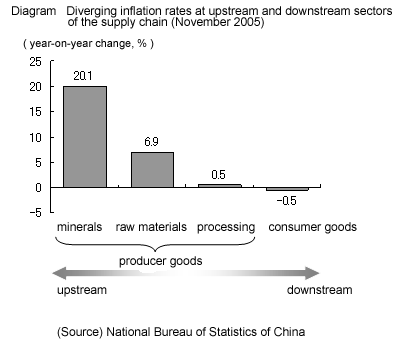China's economic growth is estimated to have reached an admirable 9.4% in 2005. However, the Chinese economy is likely to slow down to under 8% in 2006, against the backdrop of such factors as a decline in corporate earnings due to surges in the prices of raw materials and excessive production, a drop in real estate and stock prices, and aggravated trade frictions. Meanwhile, with China's foreign exchange reserves ballooning on the back of a large surplus in its balance of payments, upward pressure on the yuan should increase further.
Corporate earnings are declining in the processing and consumer goods sectors due to soaring prices of raw materials and excessive production. Despite the fact that input prices are rising, the prices of consumer goods have remained stable, and the increase in input prices has not been translated into higher output prices. This comes against the backdrop of increasingly excessive production capacity in many sectors such as steel, cement and nonferrous metals as a result of the investment boom seen since 2003. Far from rising, the prices of such products are in fact plunging amid increasing inventory. Faced with a rapidly deteriorating business environment, companies will have to hold back on production and investment.
In an effort to stamp out the real estate bubble, beginning in the spring of 2005 Chinese authorities introduced a series of policy instruments such as raising interest rates on mortgages and bolstering tax measures related to real estate transactions. In response, the real estate markets in major cities such as Shanghai are entering an adjustment phase. Meanwhile, stock prices are foundering at levels that are about half those of their peak in June 2001, triggered by the implementation of a plan to release non-negotiable shares into the market. Such declines in asset prices will likely throw a wet blanket on consumption.
On the other hand, trade frictions are worsening as China's trade surplus balloons, and the country's export environment is getting severe. In fact, growth in China's imports (in dollar terms) is much lower than that of exports. During January-November 2005, exports surged 29.7% compared to the same period the previous year, but growth in imports was just 17.1% (when the spike in oil prices is taken into consideration, real growth in imports becomes even lower). When we consider that China's trade is dominated by importing machinery and intermediate goods from overseas and exporting processed goods, this recent turn for the worse in imports indicates a high likelihood exports will slow down in the future.
Amid the rapid rise in China's trade imbalance, calls for a revaluation of the yuan are coming from industrial countries, particularly the United States. In response to such demands, on July 21, 2005, China revalued the yuan by 2.1% and simultaneously changed its foreign exchange regime to a managed float system from its traditional dollar peg. However, the authorities are continuing to intervene massively in the foreign exchange market to slow the pace at which the yuan rises. As a result, China's foreign exchange reserves are increasing at a pace that is little changed from before (roughly $20 billion a month), and in early 2006 China will likely surpass Japan to become the world's largest holder of foreign exchange reserves. Faced with pressure from both the market and foreign governments, Chinese authorities would have no choice but to allow the yuan to rise at a faster pace.



